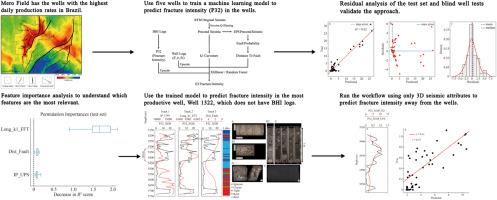A data-driven approach to predict fracture intensity using machine learning for presalt carbonate reservoirs: A feasibility study in the Mero Field, Santos Basin, Brazil
IF 3.6
引用次数: 0
Abstract
Predicting fracture intensity is essential for optimising reservoir production and mitigating drilling risks in the Brazilian pre-salt layer. However, previous studies rely excessively on conceptual models and typically do not integrate multiple types of data to perform such task. Moreover, to date, no feasibility-like studies have assessed the reasonableness of such approaches. We propose a data-driven approach that utilises upscaled well logs (Young's modulus, Poisson's ratio, and silica content) alongside seismic attributes (curvature, distance to fault) to predict fracture intensity. The distance to fault is measured using the fault probability volume estimated by a pre-trained convolutional neural network (CNN). We evaluate the effectiveness of this data-driven approach employing two tree-ensemble models, eXtreme Gradient Boosting (XGBoost) and Random Forest, to estimate the volumetric fracture intensity (P32) in the wells. Regression and residual analyses indicate that XGBoost outperforms Random Forest. Results from feature importance methods, such as permutation importance and Shapley Additive explanations (SHAP), highlight curvature as the most important feature, followed by distance to fault, Young's modulus (or P-Impedance), silica content, and Poisson's ratio. The approach has been validated with rock sampling information and two blind tests. Consequently, we believe this workflow can be applied to other wells in nearby fields. The study offers a valuable tool for quantitatively estimating fracture intensity in pre-salt reservoirs. Future research may use this study as a reference for estimating fracture intensity within a seismic volume. The predicted fracture intensity estimates can enhance the reliability of reservoir porosity models and serve as a geohazard indicator to mitigate drilling risks.

利用机器学习预测盐下碳酸盐岩储层裂缝强度的数据驱动方法:巴西Santos盆地Mero油田的可行性研究
预测裂缝强度对于优化储层产量和降低巴西盐下层钻井风险至关重要。然而,以往的研究过度依赖于概念模型,通常没有整合多种类型的数据来完成这一任务。此外,到目前为止,还没有可行性研究评估这些方法的合理性。我们提出了一种数据驱动的方法,利用放大的测井曲线(杨氏模量、泊松比和二氧化硅含量)和地震属性(曲率、断层距离)来预测裂缝强度。利用预训练卷积神经网络(CNN)估计的故障概率体积来测量到故障的距离。我们采用极端梯度增强(XGBoost)和随机森林(Random Forest)两种树系模型来评估这种数据驱动方法的有效性,以估计井中的体积破裂强度(P32)。回归和残差分析表明,XGBoost优于随机森林。特征重要性方法的结果,如排列重要性和Shapley加性解释(SHAP),强调曲率是最重要的特征,其次是到断层的距离,杨氏模量(或p -阻抗),二氧化硅含量和泊松比。该方法已通过岩石取样信息和两次盲测进行了验证。因此,我们相信该工作流程可以应用于附近油田的其他井。该研究为定量估计盐下储层裂缝强度提供了有价值的工具。未来的研究可以将此研究作为估计地震体内裂缝强度的参考。裂缝强度预测可提高储层孔隙度模型的可靠性,并可作为地质灾害指标,降低钻井风险。
本文章由计算机程序翻译,如有差异,请以英文原文为准。
求助全文
约1分钟内获得全文
求助全文

 求助内容:
求助内容: 应助结果提醒方式:
应助结果提醒方式:


